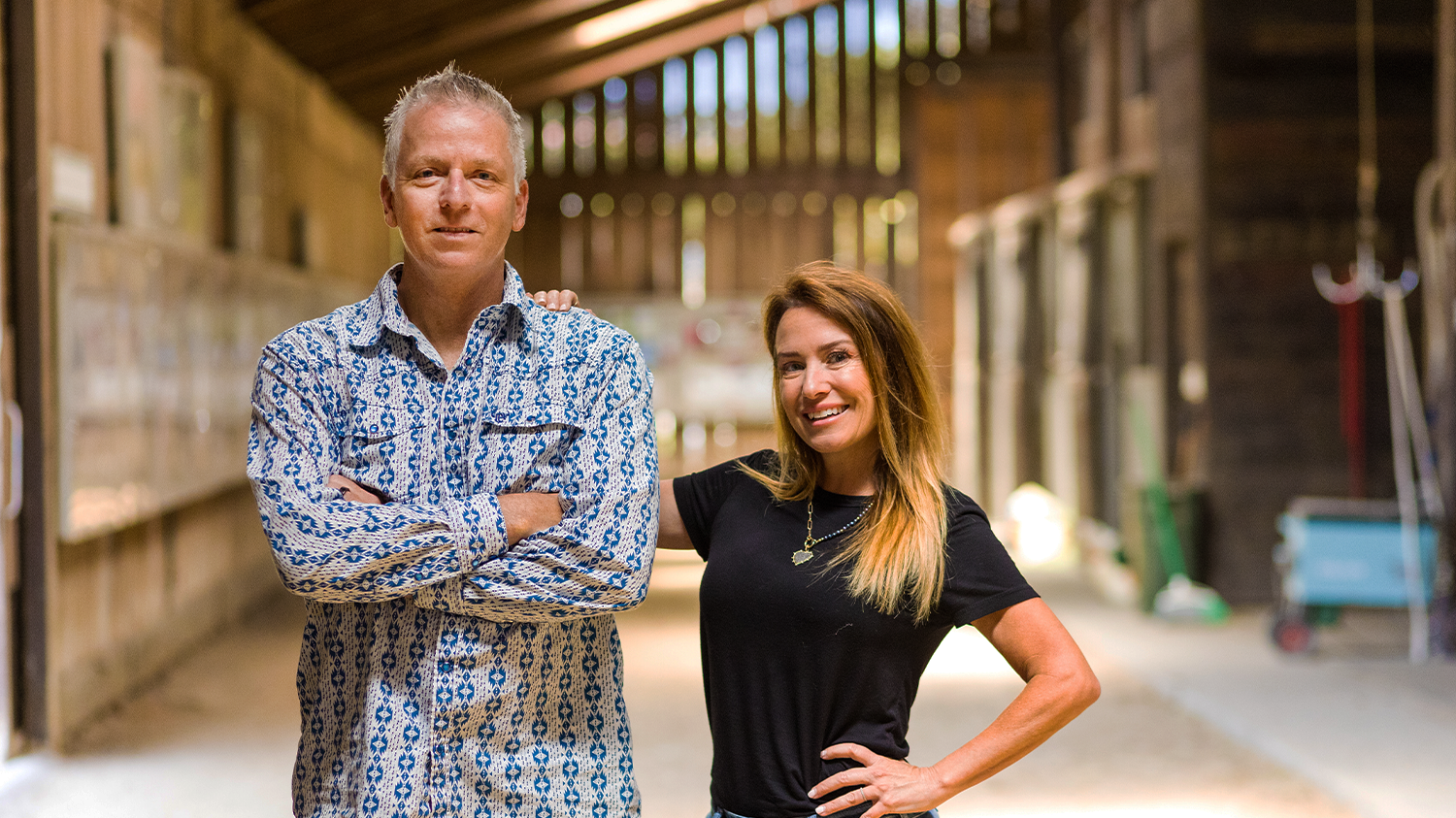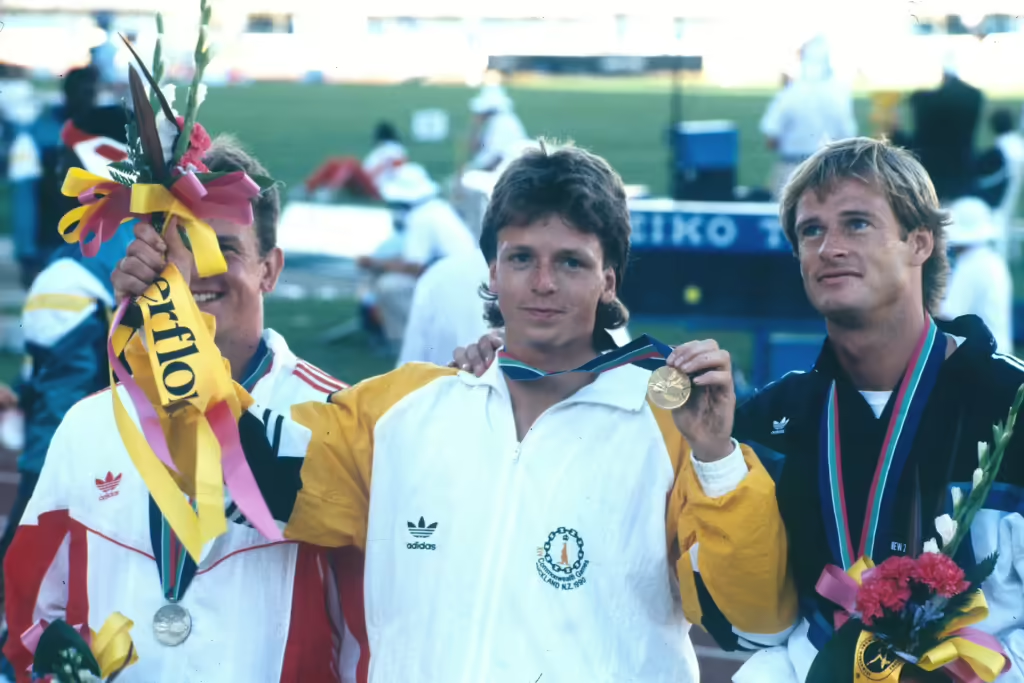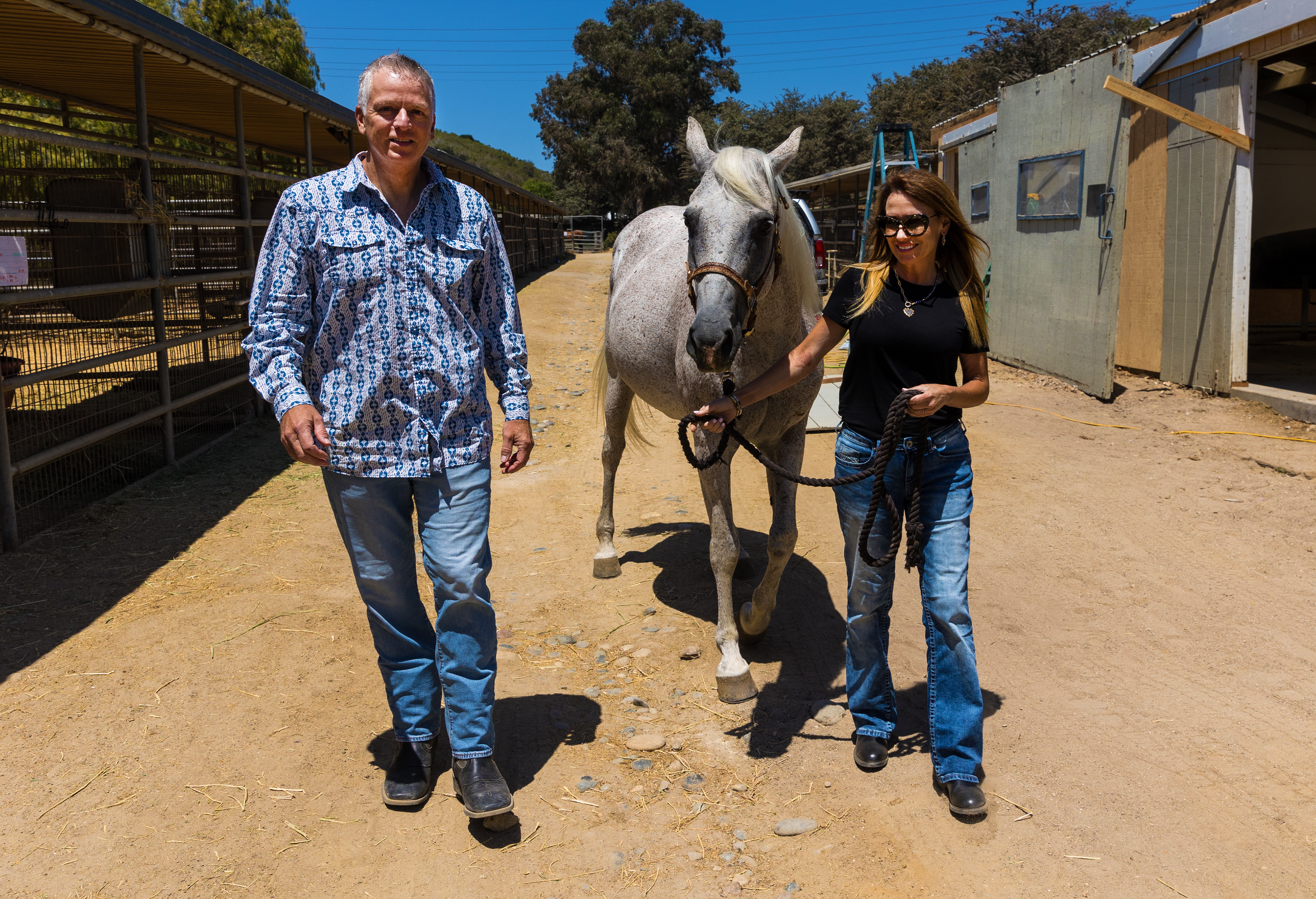Raising the Bar: Simon Arkell’s Intense Work Ethic as an Olympic Athlete was the Catalyst for His Success as an Entreprenuer

Simon and Caprice Arkell purchased the Varian Equestrian Center in the summer of 2023 after Simon's startup, Deep Lens, was acquired by Paradigm. (Photo/Pat Pemberton)
Simon Arkell didn’t know how he would pay for an MBA at Cal Poly, but he knew he had to be in San Luis Obispo, where fellow pole vaulter Dean Starkey could help him train for the 1996 Olympics.
“He had no money,” Starkey said. “He had a junky car he called Betsy; It was a big old boat.”
Starkey’s natural athleticism and Arkell’s structured workouts proved to be a successful pairing, though, helping Arkell win $14,000 at the 1993 Athletics Grand Prix Series in his native Australia.
“And that was exactly what it cost me to finish my MBA,” Arkell said. “It was one of those lucky, Universe Provides moments.”
Taking calculated risks, like coming to Cal Poly with little funds, has helped Arkell succeed both as a two-time former Olympic athlete and a successful serial entrepreneur, whose ventures in health care are now benefiting cancer patients.
“I’m a big believer in risk taking,” Arkell said from the Varian Equestrian Center, which he and his wife Caprice purchased in the summer of 2023. “Taking risks but not jumping off a cliff and hoping that someone throws you a parachute on the way down. It’s managing all the variables and analyzing them really closely and then taking a big step.”
Olympic Dreams
As a boy growing up in South Australia, Arkell conceded, he wasn’t a particularly good athlete. But in 1977, at age 11, he decided to embark on his first major life challenge.
“I decided after seeing a documentary with my stepdad about the Olympics that I wanted to be in the Olympics one day,” he said.
When a friend introduced him to pole vaulting, he decided that was going to be the sport that got him there.
“I made a decision that no one would train harder than me,” he said. “I just kept training and training, and I got better and better.”

As a pole vaulter, Simon Arkell was a 5-time NCAA all-American and 2-time Olympian, who broke numerous records in his native Australia. (Photo courtesy of Simon Arkell)
Knowing he had to come to the United States to have an advantage on the Australian team, he competed at the University of New Mexico, where he became a five-time all-American.
“While I was there, I improved from 16 feet 9 inches to 18 feet 5 inches in five years,” Arkell said. “And that was enough for a national record and qualifying for my first Olympic games.”
The road to the 1992 Barcelona Olympics and the games themselves, he said, entailed world travels, staying in five-star hotels and rubbing elbows with famous athletes, like the U.S. basketball “Dream Team” and tennis star Michael Chang.
“People get so attached to the outcome and the destination, and you forget to smell the coffee along the way,” said Arkell, who became the first Australian pole vaulter to make the Olympics since 1976. “At the opening ceremonies, you’ve got 100,000 people screaming, and they’re lighting the Olympic torch right in front of you.”
A tactical mistake, he said, led to a disappointing performance – and no medals — in the Barcelona games. With a chip on his shoulder, he decided he would train even harder to make the 1996 Olympics in Atlanta.
To achieve that, he reached out to Starkey — a former two-time NCAA champ for the University of Illinois and World Championships bronze medalist — and announced he was coming to Cal Poly.
Starkey had planned to move to Florida, but Arkell convinced him to stay in California, where both were coached by Olympic medalist Jan Johnson.
“I didn’t realize the main reason he was coming was to train with me,” Starkey said.
“I made a decision that no one would train harder than me. I just kept training and training and got better and better.”
Simon Arkell
With an economics degree from University of New Mexico, Arkell enrolled in Cal Poly’s MBA program in the fall of 1992.
“I didn’t know how I was going to pay for it because it was out-of-state tuition,” Arkell said. “So I just registered and hoped for the best.”
In 1993, he returned to his hometown in Adelaide, Australia, where he won the Athletics Grand Prix – an annual competition for track and field athletes aiming for the Olympics, World Championships or Commonwealth Games – winning money for his tuition.
Creative Outlet
Arkell’s athletic feats have landed him in hall of fames in Australia and the University of New Mexico. But while Arkell was training and competing, he was also leaping into business startups, launching his first venture while at the University of New Mexico.
“It was called Desktop Media of New Mexico,” Arkell said. “It was an advertising company where we gave out calendars to students for free and sold advertising on them.”
His business ideas continued at Cal Poly, where he and Starkey launched an online business selling pole vaulting gear and Arkell ran a software export business.
“When you’re an athlete, you can’t get a nine-to-five job,” Arkell said. “So I never sent my resume to someone and said, ‘Hey, can you hire me?’ I’ve always just done deals or started companies.”
In January of 1996, months before the Atlanta Olympics, he became the first Australian to break the 19-foot barrier.
“I was impressed when he jumped 19 feet because that was a huge jump,” Starkey said. “I was so proud of him when he did that.”
While his 19-foot jump helped launch him to the top of the world rankings, Arkell cracked a bone in his ankle a couple of months later, which impacted his Olympic performance.

Simon Arkell won numerous medals as a competetive pole vaulter, which allowed hm to compete in consecutive Olympics. (Photo courtesy of Simon Arkell)
“I kind of hobbled my way over the finish line,” he said. “I still competed, but it wasn’t a good outcome. So it was both a moment of incredible pride, achieving my childhood goal, but also disappointment because I knew I was capable of placing really highly.”
After the 1996 Olympics, Arkell focused more on startups. His LinkedIn page lists a scroll of businesses he has launched – and it doesn’t include every one.
“He loves it,” said his wife, Caprice, who met Arkell in Laguna Beach 13 years ago. “A couple of years ago, I realized that it’s his creative outlet.”
The work ethic and drive Arkell gained from competing, Starkey said, easily transferred to business.
“I think high-level sports is a great catalyst for anyone that wants to be in business,” said Starkey, who owns Arizona Pole Vault Academy.
In 2009, Arkell ventured into the health-tech industry, starting with Predixion Software, which raised $46 million from venture capitalists. In 2017, he co-founded Deep Lens, which used artificial intelligence to identify tumors and match cancer patients with potentially life-saving clinical trials.
The technology helped expedite the drug approval process and expand patient access to treatment.
“We helped enroll so many people into trials that may have died had they not had access,” Arkell said.
When healthcare technology company Paradigm acquired Deep Lens in May of 2022, Arkell was financially set.
“It’s probably no surprise that this was the best financial outcome that I’ve had in my career,” said Arkell, who lost his mother to cancer not long before that. “Because it was helping people, and it was mission driven.”

Simon and Caprice Arkell lead a horse named Rebel out of its stall. The couple own Varian Equestian Center, which boards horses in Arroyo Grande. (Photo/Pat Pemberton)
That success didn’t stop Arkell, though. With his earnings, he and Caprice purchased the Varian Equestrian Center, where the late Shelia Varian had established an international reputation for breeding Arabian horses.
While the Arkells weren’t horse experts, they pursued the ranch, which was losing tens of thousands of dollars monthly.
“It was like financial suicide to buy this place if you didn’t know everything that was going on,” he said. “And because we did, we made the appropriate changes and on Month One, it broke even, and it has made money ever since.”
Arkell, an active alumnus, credits the MBA program with giving him the confidence needed to pursue business ventures.
“Caprice and I live by this credo, which is to bite off more than you can chew and chew like hell,” he said. “It’s a good way to live because you’re always moving forward, and there’s always something exciting happening.”
A Helpful Vision
While the ranch is located close to ten miles east of the coast, an ocean breeze keeps it cool as Arkell leads a horse named Rebel out of his stall.
Their daughter, Sophie, who will begin attending Cal Poly in the fall, has been an avid barrel racer for a while.
“We probably wouldn’t have done this if she wasn’t into horses,” Arkell concedes, then adds, with a laugh: “Or if ‘Yellowstone’ hadn’t come out.”
The center boards horses, which also allows Caprice more time with animals.
“I’d love to get some rescue farm animals here,” she says. “We’ll see where life takes us.”
The center will host a small number of weddings and charity events, Arkell said, including fundraisers for Megan’s Wings, a nonprofit a friend launched after his 9-year-old daughter died of leukemia.
Arkell and another friend have been instrumental in raising funds for the charity, with over $1 million raised so far.
“It just tore me apart to see not only how sad it was for a young girl to die of leukemia, but to also see the effect it had on the family,” Arkell told Australian Olympians Magazine. “Megan’s parents will never be the same.”
While Arkell could easily retire, Starkey thinks society will continue to benefit from his initiatives.
“It takes people like him to have a vision to create things that don’t exist,” Starkey said.
Cal Poly’s Center for Innovation & Entreprenuership provides students with the tools, knowledge and connections needed to launch successful startups. Your support for the CIE helps prepare students to have a positive impact on communities.
